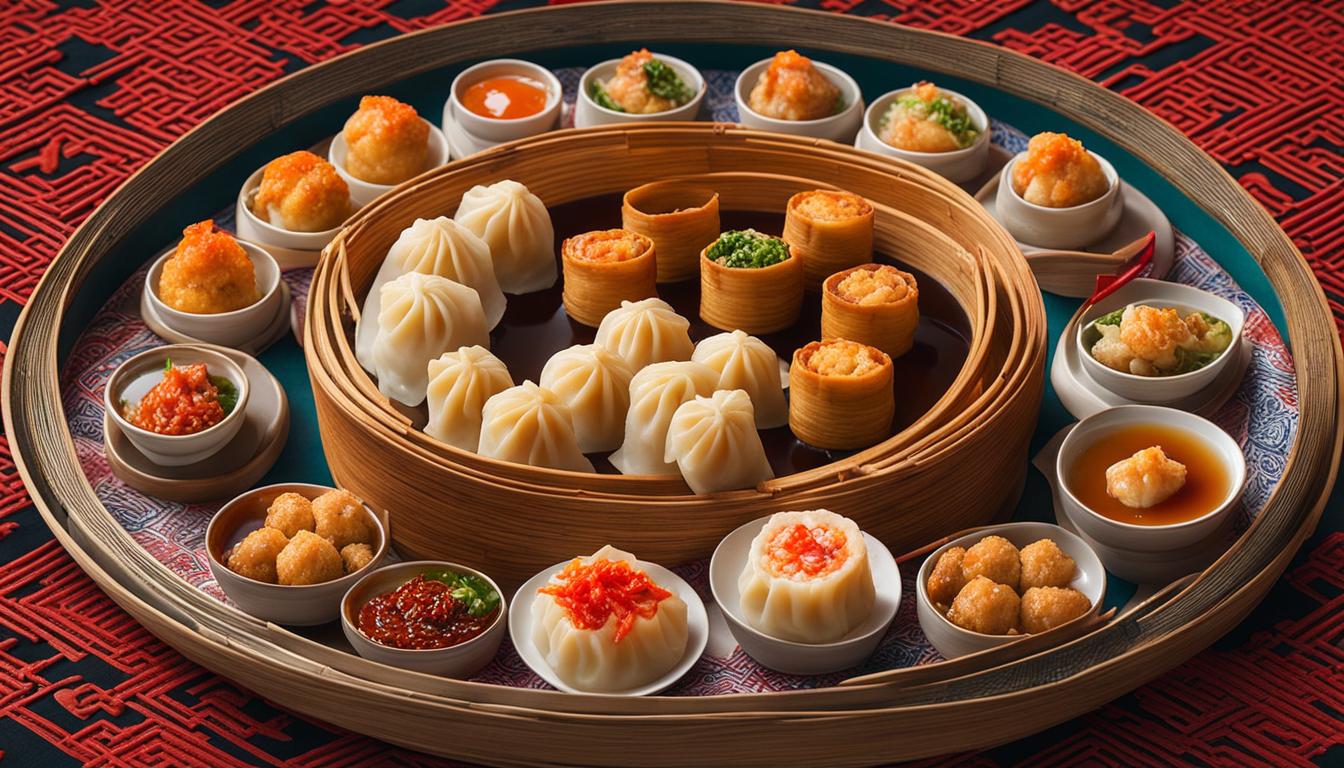Welcome to a culinary adventure like no other as we delve into the world of Chinese dim sum. Prepare to tantalize your taste buds with the rich flavors and culinary traditions of traditional Chinese dim sum. From the moment these bite-sized delights touch your lips, you will be transported to a world of gastronomic wonder.
Chinese dim sum is a beloved cuisine that offers a wide array of delectable dishes. From steamed dumplings to fried delicacies, each bite is a harmonious blend of flavors and textures. Whether you’re a dim sum enthusiast or new to the experience, this article will guide you through the intricate world of Chinese dim sum and uncover the secrets behind its enduring popularity.
Join us as we embark on a flavorful journey that traces the history and origins of Chinese dim sum, explores the delicate delight of steamed dim sum, savors the crispy perfection of fried dim sum, and unravels the customs and etiquette associated with enjoying dim sum in Chinese culture.
Get ready to indulge in the authentic flavors of traditional Chinese dim sum and discover why this culinary tradition has captivated hearts and palates around the world. Let the feast begin!
The History and Origins of Chinese Dim Sum
Chinese dim sum is not just a culinary delight; it is a showcase of history and tradition. Delving into the origins of Chinese dim sum takes us back in time, unraveling the fascinating evolution of this beloved cuisine.
The history of Chinese dim sum can be traced back to ancient China, where it originated as a form of street food. Vendors would prepare small, bite-sized dishes to offer weary travelers and workers a quick and delicious meal. These humble beginnings laid the foundation for what would eventually become a cherished culinary tradition.
Over the centuries, dim sum blossomed into an integral part of Chinese culture and cuisine. As its popularity grew, dim sum transitioned from street food to being served in elegant tea houses and restaurants. These establishments became a gathering place for families and friends, where they could enjoy a leisurely meal of delectable dim sum while sipping on fragrant tea.
The traditional dim sum dishes that have been passed down through generations continue to enchant diners to this day. From the delicate and translucent har gow (shrimp dumplings) to the aromatic and savory zhaliang (rice noodle roll filled with Chinese doughnut), each dish offers a unique combination of flavors and textures.

As dim sum continues to gain global recognition, it captures the hearts and palates of food enthusiasts worldwide. Whether enjoyed at a bustling dim sum restaurant or prepared at home, the history and origins of Chinese dim sum remind us of the rich culinary heritage that lives on through these delectable dishes.
Steamed Dim Sum: A Delicate Delight
When it comes to Chinese dim sum, one cannot overlook the art of steaming. Steamed dim sum dishes are revered for their delicate flavors and textures, making them a staple in any dim sum feast. From the classic siu mai to the fluffy char siu bao, steamed dim sum offers a wide variety of dishes to satisfy every palate.
One of the most popular steamed dim sum dishes is siu mai, also known as pork dumplings. These bite-sized delights are filled with a savory mixture of ground pork, shrimp, and aromatic seasonings. The tender pork filling, coupled with the delicate dumpling wrapper, creates a harmonious combination of flavors with every bite.
Another crowd favorite is the char siu bao, a steamed barbecue pork bun. These fluffy buns are filled with succulent pieces of char siu, a sweet and savory roasted pork. The soft, pillowy texture of the steamed bun contrasts perfectly with the juicy and flavorful filling, creating a truly satisfying culinary experience.
Steamed dumplings, such as the har gow (shrimp dumplings) and chicken shu mai, are also beloved steamed dim sum dishes. These translucent and plump dumplings are prized for their delicate skin and delectable fillings. Each bite bursts with the flavors of fresh seafood and tender chicken, showcasing the exquisite craftsmanship of dim sum chefs.

If you’re looking to recreate the magic of steamed dim sum in your own kitchen, here are a few tips to keep in mind:
1. Start with quality ingredients: Fresh seafood, tender meat, and aromatic spices are essential for creating delicious steamed dim sum.
2. Master the art of dumpling wrappers: Achieving the perfect balance between thin and sturdy dumpling wrappers is crucial. Practice rolling and stuffing the wrappers for consistent results.
3. Fine-tune your steaming technique: Proper steaming ensures that the dim sum retains its shape, texture, and flavors. Invest in a steamer basket or bamboo steamer for authentic results.
4. Experiment with fillings and flavors: While traditional fillings are popular, don’t be afraid to get creative and try new combinations. Incorporate vegetables, tofu, or even exotic meats to customize your steamed dim sum.
By following these tips and techniques, you can master the art of making steamed dim sum at home and enjoy these delicate delights anytime you crave them.
Fried Dim Sum: Crispy Perfection
In this section, we will explore the tantalizing world of fried dim sum and discover the crispy perfection it brings to the table. Fried dim sum offers a delightful contrast to its steamed counterparts, with a satisfying crunch and a burst of flavors. From the addictive deep-fried spring rolls to the savory turnip cakes, fried dim sum dishes are sure to satisfy your cravings.
One popular fried dim sum dish is the deep-fried spring roll. These golden parcels are filled with a savory mixture of vegetables, meat, and aromatic spices. The crispy exterior gives way to a flavorful and juicy center, making it a favorite among dim sum enthusiasts.

Another well-loved fried dim sum option is the turnip cake. Made from grated turnips and rice flour, it is pan-fried to perfection, resulting in a crispy exterior and a soft, savory interior. This dish is often served with a side of soy sauce for dipping.
To recreate these crispy perfection morsels at home, you’ll need a few key techniques and ingredients. The secret lies in achieving the right frying temperature and using the right combination of sauces and spices to elevate the flavors. With the right guidance, you can bring the deliciousness of fried dim sum right into your kitchen.
Stay tuned for the next section, where we will explore the etiquette and tea pairings that enhance the authentic dim sum dining experience.
An Authentic Dining Experience: Dim Sum Etiquette and Tea Pairings
When it comes to enjoying dim sum, it’s not just about the delicious food. Understanding the customs and etiquette associated with this traditional Chinese dining experience elevates the meal to a whole new level. Let’s explore the art of dim sum pouring tea and the various types of Chinese tea that are traditionally served alongside dim sum.
Dim sum etiquette is an integral part of the dining experience. As you sit at the table, take note of the tea pot and cups before you. It is customary for the eldest or most honored person to pour the tea for others, showing respect and reverence. To receive a refill, lightly tap two fingers on the table near your cup as a gesture of appreciation.
Chinese tea is the perfect companion to dim sum, with its diverse range of flavors and aromas. Green tea, such as Longjing or Dragon Well, is often served to cleanse the palate and aid in digestion. Oolong tea, such as Tie Guan Yin or Iron Goddess, offers a fragrant and slightly floral taste that pairs beautifully with steamed dim sum. For a richer and earthier flavor, try Pu-erh tea, which brings depth to fried dim sum dishes.
To fully appreciate the flavors of both the dim sum and the tea, it’s important to understand the art of tea pairings. The delicate flavors of steamed dumplings, like har gow or shrimp dumplings, are complemented by a light-bodied and floral green tea. Fried dim sum, on the other hand, calls for a stronger and more robust tea, such as oolong or Pu-erh, to balance the richness of the dish.






